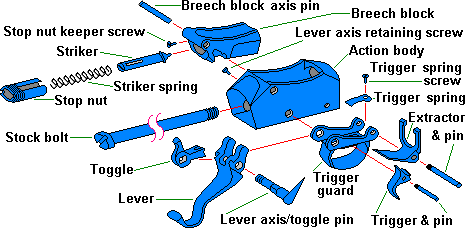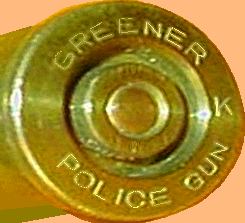Brass Cased Loads
WW Greener
Martini Henry FAQ
|
|
|
|
|---|
|
Brass Cased Loads WW Greener Martini Henry FAQ |
Greener Police Shotgun Cartridge
|
|---|
The Greener police shotgun was always a bit of an oddity... Back in the 1960s & 70s I had some ideas about introducing it into service with the UK police, with several unusual purposes, including car stopping, wire cutting and an anti-airship capability. The non interchangeability feature of the ammunition and the high service pressure made this weapon ideal for the purposes envisaged.
I was not successful in creating any interest in the Home Office and so, like so many other worthwhile objectives, the project was shelved.
I had some information... many years ago, from a Mr. Onions (then working at Elderkin's, but previously at Greener). However the notes that I took at that time were in the filing system at my office when my company 'Apex Enterprises' went bankrupt and so they have been lost, along with thousands of other documents and drawings that would have made good reading on a website of this nature.
Since I started compiling this website I have sought to regain my lost information about the Greener 14 bore, but have been unable to obtain any drawings or details. However while researching something else, I stumbled upon several websites that deal with Martini actioned weapons and there are several mentions of the Greener police shotgun, simply because it has a Martini action. I acknowledge that much of the following detail has either come from those sources or has been re-triggered in my mind because of them.
|
The diagram at right gives an idea of the design and workings of a large framed Martini action. The Martini action is a strong box-like action, designed by Friederich von Martini of Switzerland, that lends itself to the manufacture of robust single shot weapons. It has a falling block that is lowered for loading by a lever that also cocks the striker ready to fire. The last portion of downward movement of the breech block causes the ejector to rotate on it's axis pin and thus move the spent cartridge case from the chamber (far enough to be removed by the fingers). |

|
|---|
There have been three versions of this weapon/cartridge combination, with different chambering and borings to suit different uses within a mark no.
The Mark III was chambered for three different types of cartridge...
The original 14 1/2 gauge Mark I shells
Standard 12 gauge 2 3/4" shells
Special bottle necked shells for the Egyptian police
The objective of the unusual calibres was to limit the use of stolen weapons, but the MK I/14 was easily circumvented by wrapping a paper sleeve around a conventional 16 bore cartridge.
|
This led to the development of the Mk III bottle necked shell illustrated at right, it was 0.782" diameter at the base, and was necked down to 0.740" for the remainder of it's length. The overall length of the double diameter shell was 2.875". |

|
|---|
The bottle necked Mark III Special Greener Police Gun Shotshell. Case of drawn brass, crimped closure (10 point folded or roll crimp). The cartridge was specially designed for use with Greener's Police Gun Mark III and deliberately intended to be used with nothing else. The Police Gun was a Martini-Action shotgun used by British Colonial Police forces (particularly in Egypt) during the early 1900's. It was adapted so that it would only allow cartridges, made specifically for the weapon, to be fired.
|
This bottle necked form of the cartridge was enough to prevent the weapon's unauthorized use on it's own, but a second feature was included by Greener... By adding a large annular groove in the base of the cartridge head and two lugs that protrude from the front face of the breech block. When a cartridge is loaded into the chamber, the lugs registered in the annular groove in the base of the case. This meant that the weapon could only be closed and fired if the special grooved cartridges were used. |

|
 Open form of crimp
Open form of crimp(Slightly smaller scale) |
|---|
Written... 17 October 2003, revised... 01 December 2003, Upgraded... 26 January 2007, Code Altered... 18 May 2008,
|